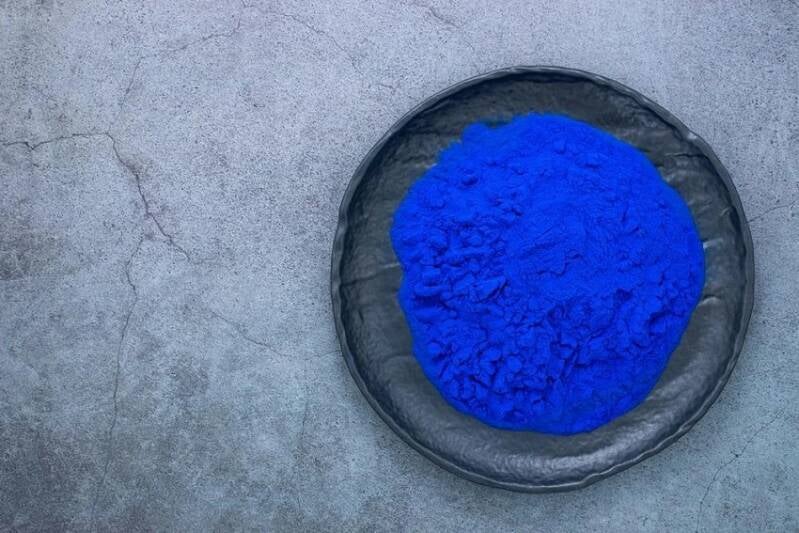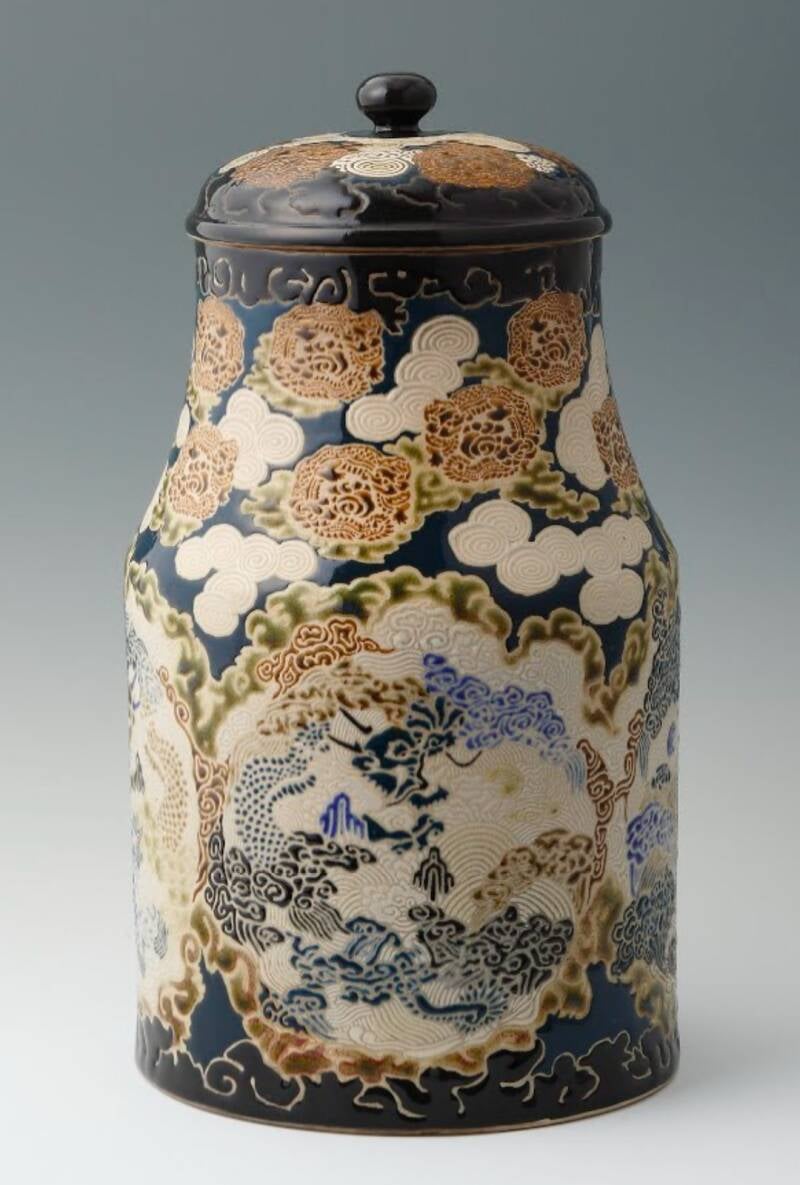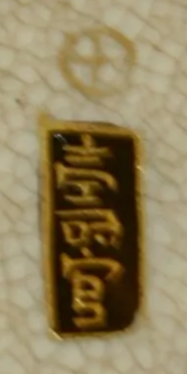The Beauty of Gosu Blue Satsuma

By Howard Reed and Richard Cress
The Beauty of Gosu Blue Satsuma
Some of the most desirable pieces of Satsuma ware are those decorated with gosu blue enamels. For a better understanding, here we present some aspects related to gosu blue and its use on Japanese ceramics, especially on Satsuma wares.
What is Gosu?
Gosu (呉須) is the Japanese term for traditional cobalt-based blue pigments and enamels. Japanese use of the term gosu may indicate either the pigment itself, overglaze glassy enamels made using this pigment, underglaze use of the same pigment (ie, as in sometsuke blue-on-white porcelain) or even sometsuke ware itself. However, in regard to Satsuma ware, the term gosu always means overglaze glassy enamels made using this pigment. Other uses of the term gosu are discussed in the site’s Illustrated Glossary.




Gosu pigment is prepared from raw ores of cobalt, sometimes sourced within Japan but more commonly imported from China. Cobalt pigments first came to China from West Asia via the Silk Road and were originally used in Iraq and Persia. An English word equivalent to gosu is “zaffre”, which is an archaic word for a deep blue pigment obtained by roasting various ores of cobalt to produce impure cobalt oxide.
The main mineral used to produce gosu is asbolite[1], which is a black, earthy mineral containing hydrated oxides of manganese, nickel and cobalt), although other minerals containing cobalt may also be used. The variable concentrations of cobalt and the other metals in asbolite yield a wide variety of shades of blue in the final pigment, which may vary from almost black through greenish and greyish tones to a lovely mid-toned sapphire blue. It is said that firing processes (temperature and time) also affects the colour.
Irene Stitt’s Japanese Ceramics of the Last 100 Years (1971) reports that the raw gosu mineral is found in pebbles in oriental riverbeds (p 126), although we have been unable to confirm this.
Gosu pigment will always oxidise to black if exposed to the air in a kiln. However, covering the raw pigment with a glaze prior to firing leads to an unoxidised blue colour, which is why the pigment is always applied underglaze on sometsuke porcelain. The raw pigment is never applied without this covering glaze on either porcelain or earthenware, including Satsuma wares.
However, gosu pigment can be combined with a variety of other earth materials to produce blue overglaze enamels. It is these blue overglaze enamels which characterise gosu blue Satsuma wares. Gosu blue Satsuma was sometimes called “Imperial Satsuma” by Europeans in the late 19th century. Takamatsu (1878) gives a formula for a glassy blue enamel used on Kutani ware as also including shiratama (powdered clear lead glass) and tonotsuchi (white lead oxide) in addition to what was probably hanakonjo, said to be a mixture of crude cobalt oxides, clays and alkalies.[2]
Gosu blue enamel is analogous to the European pigment “smalt”, which is deep blue coloured potassium glass prepared by including a cobalt compound, typically cobalt oxide or cobalt carbonate, in a glass melt. Cobalt is a very intense colouring agent and very little is required to produce a noticeable colour in the glass. When ground, smalt was used as an artist’s blue pigment, primarily from the 15th to the 18th centuries. Takamatsu equates hanakonjo enamel with smalt (pp 23, 29), as does Andacht.[3]

An Imperial Satsuma pear-shaped vase with flaring neck and short foot, 19th century.

When was Gosu Blue Satsuma Produced?
Unfortunately, there is no unanimity amongst either scholars or collectors on these questions. As far as is known, there is no scholarly work on dating gosu blue Satsuma.
Sandra Andacht’s Treasury of Satsuma (1981) labels the many fine examples of gosu blue Satsuma shown in that book as all dating between 1795 and 1872 (ie late Edo and the very beginning of Meiji). Andacht dates the beginning of this period to early in the Kansei era (1789-1801), following the introduction to Satsuma province of existing Kyoto techniques for decorating earthenware with overglaze enamels (pp 37-38). According to Andacht, the end of this gosu blue period was based on the introduction of European industrially refined cobalt oxide to Arita in 1869 by German chemist Gottfried Wagener (p 39). Being a cheaper product than gosu, this alternative “cobalt blue” pigment rapidly spread throughout Japan, particularly in the case of the underglaze blue used for decorating porcelain, such as Arita and Imari wares.
Hazel Gorham’s Japanese and Oriental Ceramics (1971), puts a similar view, suggesting that nishikide (brocade) and kin nishikide (gold brocade) Satsuma was being produced from late in the 18th century (pp 80-81).
However, many collectors and some later writers hold the view that the majority of gosu blue Satsuma production falls in a much smaller and later window (say 1850-70). Some collectors have extended this small production window to approximately 1850 -1900. While not denying that earlier nishikide and kin nishikide Satsuma wares were produced, it is considered that the great majority of pieces (including the very great majority of pieces available to Western collectors) were produced AFTER the time when Japan began to export large quantities of ceramics to the prime Western markets, ie from 1870. Gisela Jahn’s Meiji Ceramics (2004) states that the two largest kilns in Satsuma province (those of Chin Jukan and Boku Seikan) both expanded “enormously” after the rapid growth of the export trade at the beginning of Meiji (p 107).
Indeed, there seems to be good reason to hold the view that many gosu blue pieces were produced during the period 1870-1900 (or even slightly later). As the Gotheborg website says: “Some prefer a later date (say mid to late Meiji, the hey-day of Japanese export ceramics, at least by quantity).” There seems no reason to believe that export of gosu blue Satsuma would do anything else but mirror the rises and falls in export of other types of Satsuma ware, providing that gosu was still in use and remained readily available.
Some degree of corroborating evidence is provided by the many examples of gosu blue Satsuma with raised gold slip outlining (moriage technique), which became very popular on Kyo Satsuma during the period 1880-1900. In addition, many gosu blue Satsuma pieces are signed by the artist (sometimes also with an impressed mark from the potter). The fashion for such marks really only got going on Kyo Satsuma in the 1880s.
The most recent substantial English book on Satsuma, Louis Lawrence’s Satsuma, The Romance of Japan (2011), goes even further. In writing on Satsuma “with heavy enamelling”, Lawrence says “I have heard them referred to as ‘imperial’, ‘Gosu’, ‘early’ and ‘Edo’ Satsuma. … They are not early pieces made in the Edo period or even the early Meiji period; they date between the 1880s and the late 1920s” (p 134). He also gives a dated example from the Yokohama workshop of Hododa with an original label indicating that it was made for exhibition circa 1900.
In conclusion, it is considered that most pieces of gosu blue Satsuma were made between 1870 and 1900. A minority may predate this period and some may postdate it, particularly if made in Kagoshima.

Satsuma Vase, signed Tokozan, Edo -Meiji Period.

A vase, signed Ishuin Chikusai, with apocryphal year ‘spring 1837’, Meiji period.

A Satsuma vase, signed Kozan with blue mon , Edo-Meiji period

Lidded jar with dragons, Tanzan Seikai - Koyo Satsuma , Late Edo- earluMeiji period.1850 - 1886.
Where was Gosu Blue Satsuma Produced?
The Gotheborg website suggests that “Satsuma Gosu Blue" was produced in very limited quantity in Kyoto in the mid-19th century”. This statement is repeated in Wikipedia. Nancy Schiffer’s Imari, Satsuma and Other Japanese Export Ceramics (1997) holds a similar position (p. 119). This implies that gosu blue Satsuma is just a type of Kyo Satsuma.
However, Andacht’s view (see pp. 39-40, cf her dating information referenced above) is that most pieces of gosu blue Satsuma were produced before the surge in production of what she calls “imitation” Satsuma, which followed key Japanese participation in European international exhibitions in 1867 and 1873. This infers that they were mostly produced in Satsuma province (modern Kagoshima Prefecture) in the southern island of Kyushu.
Some collectors (including this site) hold the view that many pieces of gosu blue Satsuma (perhaps the majority) were produced in the home of Satsuma ware, which is Kagoshima.

Chin Jukan XII with gold mon

Kinkozan with blue mon
Key evidence is support of this view is the very fine white paste, clear glaze and very fine and even pattern of crackles found on most (but not all) gosu blue Satsuma. These features are characteristic of haku ji yaki (white bodied Satsuma wares) produced in Satsuma province, including at the key kilns at Naeshirogawa.
Additional evidence is the near-universal use of gosu blue to draw the Shimazu mon (the famous “cross-in-circle”) on the base of these wares. This was the traditional colour of the Shimazu clan’s kamon (or family crest). The Shimazu clan provided Satsuma province’s daimyo (or lord). This blue colour would be of great importance to local ceramic decorators, both before and after the Meiji Restoration. However, it would be of little interest to decorators in Kyoto and other “mainland” centres, particularly after the Restoration.
It is considered that the great majority of representations of the Shimazu mon in gold, red or black are from Kyoto or the other mainland centres of Satsuma ware production. Nonetheless, it is known that a number of artists that are (or are thought to be) from Kagoshima sometimes used gold mon. These include Gyokusei, Hogetsu, Hosai, Jissei-In, Juho, Juko, Katei, Kinkoku, Kosai, Masanobu, Meigado, Muratei, Nankyo, Ryukaku, Shusui and Tomonobu. In addition, Chin Jukan, Hosai, Meigado and Tokozan occasionally used red mon. (See: Marks and makers)
With regard to blue mon, the opposite applies. Most such pieces are undoubtedly from Kagoshima. However, at least some mainland production of gosu blue wares used the blue mon. For example, some pieces by Kinkōzan, Chikusai and Fuzan include a gosu blue mon. (See: Marks and makers)
Other Characteristics of Gosu Blue Satsuma
It is difficult to say why gosu blue Satsuma is so attractive to collectors. It certainly has to do with the hard-to-define glassy grey/blue hue, which is immediately distinguishable from the dark, even-toned blue of industrial cobalt pigment.
In addition, the overall quality of gosu blue Satsuma is undoubtedly higher than the majority of Satsuma wares from Kyoto and other mainland centres. While Kyoto (in particular) and the other mainland production centres (eg Osaka, Kobe, Tokyo and Yokohama) certainly produced some outstanding pieces, they also produced vast quantities of export ceramics of poor and very poor quality. This does not seem to be the case with the Kagoshima potters and decorators. Also, there are definitely fewer gosu blue pieces available.
Another key aspect of the beauty of gosu blue Satsuma is the style of decoration. Gosu blue was generally used with traditional designs, such as brocades (nishikide), bird and flowers (kacho-ga) and various floral motifs. Geisha, family scenes, landscapes, Samurai, mythological heroes, rakan and the like, rarely appear (if at all) on gosu blue Satsuma. Many collectors prefer the more traditional motifs, as they are more related to Japanese design. Commonly, there is more “white space” on gosu blue Satsuma, which allows the design to stand out in contrast to the very pleasing crackled ivory ground.
There are a number of major shifts in decoration style in Satsuma in the late 19th century, the early 20th century and the years before the second World War. However, most (if not all) of these took place in Kyoto, Yokohama and other mainland centres of Satsuma production, rather than in Kagoshima. These various styles of decoration, as an assistance to dating Satsuma wares, are addressed in How Old Is It? Clues on Dating Satsuma Wares.

A pair of Imperial style Satsuma vases, Satsuma yaki Satsuma no kuni Ijuin Naeshirogawa Kessengyoku, Meiji period (late 19th century)

A rare gosu blue Satsuma vase depicting rakan , signed Hozan (芳山) and impressed mark of Chin Jukan, Possible:: made in the Jukan kil and decorated in Kyoto
Comparison with the Later Cobalt Dark Blue Enamel
The pleasing range of colours associated with gosu blue (from a pale greyish blue, to mid-toned and sapphire blues, slightly greenish dark blue, to very intense blue-black) is very different to the intense dark blue glaze developed during the latter years of the 19th century (mid-Meiji period) and based on imported cobalt oxide.
It is understood that it was Kinkōzan VI (Kobayashi Sōbei) who invented this dark blue glaze, based on the new cobalt blue pigment and new enamelling technologies introduced by Gottfried Wagener. Kinkōzan used this dark blue glaze to great effect in framing pictorial reserves on many of his pieces. The reserves were filled with carefully enamelled scenes and the blue ground was overgilded with detailed brocades, generally in gold but also in silver. Kinkōzan’s first blue ground Satsuma pieces may date as early as the 1880s, but they became increasingly popular from the 1890s. The factory continued to produce this style, but generally with lesser detail and quality, until its demise in either 1930 or 1932.
A number of other Satsuma producers and decorators (in particular Kyoto’s Sennosuke Kusube and Yokohama’s Takichi Hododa) also adopted this popular dark blue glaze.
A Final Word
Any conclusions regarding the dating of gosu blue Satsuma, particularly after the rise in popularity of imported industrial cobalt oxide pigment, must consider the source of the blue colouration.
Did some producers of Satsuma ware, particularly in Kagoshima, maintain access to a native Japanese source of gosu cobalt? Or, did they continue to import the more expensive and difficult to use Chinese gosu pigment?
Perhaps a third alternative is that blue enamels were produced using blue copper carbonate (ie azurite, known as konjo), instead of cobalt smalt (ie hanakonjo).
This site considers that it stands to reason that blue glazes used in the period after 1870 could only have been produced from two key blue minerals – ie konjo and hanakonjo. If it was the cobalt-based hanakonjo, then this could have only come from three sources – those of native Japanese origin, continued imports from China or (conceivably) a clever use of the imported industrial cobalt oxide (with other components) to produce the desired colour and clarity.

Kinkonzan cylindrical vase decorated in various coloured enamels and gilt on a blue ground.



As far as is known, no author has written clearly on this subject. Accordingly, this site takes no final position on it. However, it is worth pointing to information included in Takamatsu (1878). This thesis mainly addressed mineral pigments used on ceramics in Japan. Nonetheless, it also gives some important information regarding enamels used in both shippo (ie cloisonne), decorated porcelains produced in Kaga province (ie Kutani porcelains) and Raku ceramics.
The shippo enamels analysed by Takamatsu were provided by the eminent Kyoto cloisonne artist Namikawa Yasuyuki. Takamatsu concluded, based on his chemical assays, that Namikawa’s “very deep blue” enamel gained its colour from hanakonjo. The oxidised chemical composition of this enamel comprised silica (69.67%), potassium oxide (18.3%), cobalt oxide (7.06%), iron and aluminium oxides (4.5% combined) and sodium oxide (0.6%). This “very dark blue” glass could be mixed with other enamels and pigments (being shiratama (ie clear lead glass), hino-okaseki (ie silica glass) and tonotsuchi (ie white lead oxide)) to produce softer tones (see pp 38-41). In our opinion, the source of Namikawa’s cobalt, c. 1878, was very probably imported industrial cobalt oxide.
Takamatsu also reported that two kinds of blue pigment were in use for decorating porcelain products in Kaga. In terms of underglaze decoration, both “smalt” (being imported cobalt oxide) and Chinese gosu were in use. However, the smalt was considered too dark in tone and the Chinese gosu too faint. Consequently, “a mixture of the two is used according to the colour required” (p 42). Thus, Chinese gosu was still available in Kaga province, c. 1878.
Importantly, Takamatsu also reports that blue overglaze enamels at Kaga were composed of a mixture of components, being konjo, shiratama and tonotsuchi (p 42). Blue enamels on raku ware were reported as having this same basic composition (p 44).
Thus, we have some evidence that blue enamels based on blue copper carbonate (instead of cobalt, whether gosu based or imported industrial) were in use in the late 1870s in at least two important Japanese ceramics centres. Azurite is a much more common mineral than are the various ores of cobalt, including in Japan. It also has a paler range of colours than does cobalt.
This calls into question as to whether “gosu blue Satsuma” might actually be a misnomer! Only further research can address this critical question.






Maak jouw eigen website met JouwWeb